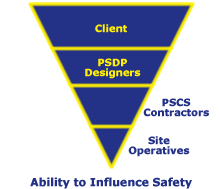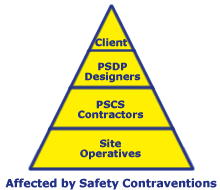Designing for Safety
Designers can make decisions that significantly reduce the risks to safety and health during the construction stage and during subsequent use and maintenance. They are therefore a key contributor to construction health and safety. 

As a designer you can directly influence safety. Designers must take account of the General Principles of Prevention when preparing designs. The Principles of Prevention are a hierarchy or risk elimination and reduction.
The General Principles of Prevention are set out in descending order of preference as follows:
- Avoid risks.
- Evaluate unavoidable risks.
- Combat risks at source.
- Adapt work to the individual, especially the design of places of work
- Adapt the place of work to technical progress.
- Replace dangerous articles, substances, or systems of work by non-dangerous or less dangerous articles, substances, or systems
- Use collective protective measures over individual measures
- Develop an adequate prevention policy
- Give appropriate training and instruction to employees.
As a designer you can directly influence safety. Some of the well-proven ways of reducing risk include:Choosing the position and design of structures to avoid or minimise risks from known site hazards, including:
- buried services, including gas pipelines, overhead and underground power lines
- traffic movements to, from, around, and adjacent to the site
- contaminated ground (for example by using driven rather than bored piles)
Designing out or minimising health hazards, for example:
- specify/permit the use of materials known to be less hazardous, e.g. low solvent adhesives and water-based paints
- avoid processes that create hazardous fumes, vapours, dust, noise or vibration, including disturbance of existing asbestos, cutting chases in brickwork and concrete, unnecessary breaking down cast in-situ piles to level or scabbling concrete
- specify the use of easy to handle materials
- design block paved areas to enable mechanical handling and laying of units
- design access areas to accommodate work-at-height equipment.
